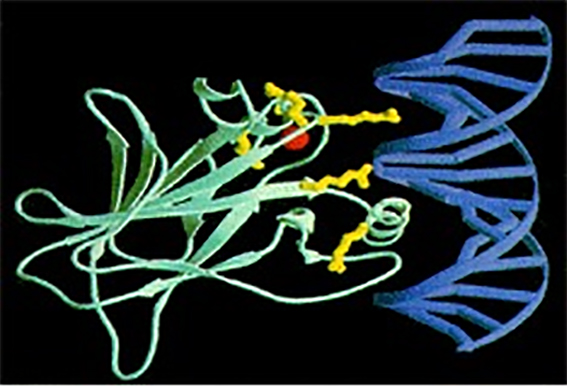
The P53 Tumor Suppressor Protein
 |
| The structure of the core domain of the p53 protein (green) bound to DNA (blue). The 6 most frequently mutated amino acids in human cancers (yellow)—all are important residues for P53 binding to DNA. The red ball is a zinc atom. |
The p53 gene is a tumor suppressor gene, i.e., its activity stops the formation of tumors; it is known as "the guardian of the genome," P53 is the most frequently mutated gene in human cancers; mutations in p53 are found in more than 50% of all cancers. The p53 gene encodes a protein that acts as a transcription factor, a regulatory protein that binds to DNA sequences and affects transcription of specific genes.
The p53 gene has been mapped to chromosome 17. In the cell, p53 protein binds DNA, which in turn stimulates the p21 gene to produce a protein that interacts with a cell division-stimulating protein (cdk2). When p21 is complexed with cdk2 the cell cannot pass to the next stage of cell division (see figure below). Mutant p53 can no longer bind DNA in an effective way, and as a consequence the p21 protein is not available to act as the 'stop signal' for cell division. Consequently, cells divide uncontrollably, and form tumors.
 |
P53 protein binds damaged DNA |
P53 protein is generally undetectable in healthy cells. Several types of events cause a rapid increase in the levels of activated p53 protein, including chemical damage to DNA, double-stranded breaks in DNA induced by ionizing radiation, or the presence of DNA-repair intermediates generated by exposure of cells to ultraviolet light. P53 is activated via posttranscriptional modifications, including phosphorylation and acetylation.
The p53 protein initiates two different responses to DNA damage: arrest of the cell cycle followed by DNA repair, or apoptosis and cell death if DNA cannot be repaired. Each of these responses is accomplished by p53 acting as a transcription factor that stimulates or represses gene expression.
Help with unraveling the molecular mechanisms of cancerous growth has come from the use of mice as models for human cancer in which powerful 'gene knockout' techniques can be used. The amount of information that exists on all aspects of p53 normal function and mutant expression in human cancers is now vast, reflecting its key role in the pathogenesis of human cancers. It is clear that p53 is just one component of a network of events that culminate in tumor formation.